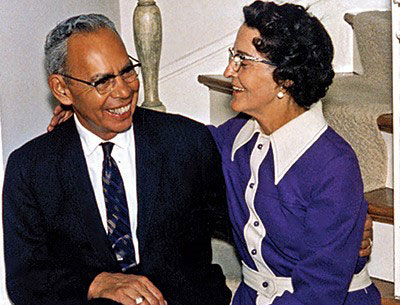Home Page
A Legacy of Generosity: Entrepreneur Eugene Garcia’s Spirit Lives on Through Gifts to His Community
 If not for the noble intentions of the trustees of an impressive yet unheralded charitable trust, few would ever know of the extraordinary generosity of an unassuming entrepreneur who made his fortune in the construction industry: Eugene (Gene) Garcia.
If not for the noble intentions of the trustees of an impressive yet unheralded charitable trust, few would ever know of the extraordinary generosity of an unassuming entrepreneur who made his fortune in the construction industry: Eugene (Gene) Garcia.
Upon Garcia’s death in 2002 at the age of 98, two trusts were created to dispose of his extensive estate: the Eugene Garcia Charitable Trust, which gifts earnings to five organizations, and the Eugene Garcia Charitable Remainder Trust. The latter was created to benefit Garcia’s only living relative, a niece, during her lifetime, after which the proceeds would benefit the same charities as the former. Garcia left behind a brief narrative of his life with the trustees, who eventually felt that more people should know of Garcia’s posthumous generosity to the Albuquerque community—so, they reached out to share his story.
Born in Trinidad, Colorado, in 1904—eight years before New Mexico became a state—Garcia was already herding sheep for his family by the time he was 10, spending days at a time out tending the flock. Although he didn’t complete elementary school, Garcia came to value knowledge and was a lifelong learner. His interests motivated him to read extensively about construction, engineering, and business management.
Garcia’s self-directed education paid off. As a young man, he started a construction business in Albuquerque and soon began landing increasingly larger jobs. Eventually, he and his wife Marie moved to Arizona at the beginning of World War II for a military construction project. Upon their return to New Mexico, still in the early 1940s, Garcia met with representatives of the U.S. Army Corps of Engineers regarding top-secret work needed in Los Alamos. After extensive negotiations, Garcia agreed to take on the project to construct buildings for power plants, a diesel plant, boiler systems, and other mechanical equipment, all for a mysterious job that was referred to only as the Manhattan Project, which was later revealed to the world as the mission that developed the first nuclear weapons.
Garcia overcame many setbacks during the grueling project. In one instance, a truck bringing a diesel engine from Texas wrecked between Española and Los Alamos, knocking the bottom out of the engine’s crankcase. Rather than moving the engine to Los Alamos and risking further damage, Garcia and his crew built a machine shop by the side of the road and worked from 6 a.m. until 6 p.m. to complete the repair.
In another example of his ingenuity, Garcia needed to get water from the mountain top to the laboratory site—through 12 miles of steep, forested terrain. He and his crew had one week to construct the water lines. They divided into several teams, stationing themselves every two miles along the route. They completed the work early, just in time for the arrival of Dr. J. Robert Oppenheimer, who later became known as the “father of the atomic bomb.” Garcia gave the University of California-Berkeley physicist a tour of the laboratory projects his company had constructed. Oppenheimer was apparently pleased.
After the war, Garcia continued to bid and win construction projects, in part because he developed methods to accomplish tasks that others couldn’t. In one project, he and his crew painted the outsides and insides of two smokestacks, each more than 200 feet tall. No one else had been willing to take the job.
Garcia worked at his now-defunct company, National Sales Inc., until he was 92. He retired to care for Marie, who had been diagnosed with cancer. A private man with only a few close friends and no children, Garcia felt strongly about supporting New Mexico institutions. He set up the charitable trusts so that he could give generously, in perpetuity, after his death.
Even well into his 90s, while in an assisted living facility in Albuquerque, Garcia was sharp as ever and continued his zest for business, according to Mike DeVenzeio, a trustee and a vice president in Wells Fargo’s Wealth Management Department in Albuquerque. Garcia loved the art of the deal and even insisted on personally negotiating the sale of his former Albuquerque home overlooking the Rio Grande. “He was a master negotiator,” said DeVenzeio. “It was a game to him.”
By Michele Sequeira and Todd Staats
© Pentera, Inc. Planned giving content. All rights reserved.
Disclaimer
